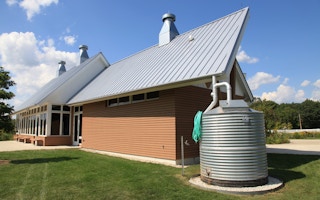Citing work from Dr Peter Coombes from Urban Water Cycle Solutions, RHAA executive officer Michael Smit said that applying water efficient measures, such as rainwater harvesting systems, into new buildings in Victoria could reduce the net present costs of water cycle management to 2050 by $6 billion, and save $3.5 billion in South East Queensland between now and 2056.
Savings break down
Speaking to The Fifth Estate, Dr Coombes said: “When you turn the tap on in your house, it comes from a dam or another water source through big pumps and pipes and storage reservoirs until it gets to your house. The water you don’t use is then discharged by another set of pipes and infrastructure to the wastewater system.
“But if you put a rainwater harvesting tank on that house, you’re using rainwater rather than getting it from the water supply system. That means a certain proportion of water is no longer travelling through all the centralised water infrastructure, so you’re deferring that cost, and that saves money.”
For example, water prices in Brisbane are currently around $3.40 for 1000 litres, but the cost of supplying water to different parts of the city, including storage, pumping, treatment and testing, means the real cost of delivering water could be over $8 a kilolitre. If the cost of delivery was taken out of account, it could save $4.6 per kilolitres.
Mr Smit said: “If the marginal cost of rainwater harvesting paid by the homeowner is $2.50/kL there is a significant community benefit. The small benefit at a household scale becomes considerable at the neighbourhood scale, significant at a city scale and massive at a regional scale measured over 20 or 30 years.”
And, as well as cost savings in delivery, rainwater harvesting could also reduce stormwater infrastructure costs and flood damage by “millions of dollars”.
Dr Coombes said rainwater tanks were “storing water, rather than it being runoff into the system”, which also helped to protect waterways and wetlands.
“So there is a double benefit of changing behaviour.”
Lack of state action
Mr Smit has argued that the financial and environmental savings that can be had from rainwater harvesting could be realised if states implement water and energy saving targets to all new buildings and significant renovations.
However, only NSW to date has implemented such a policy – through the Building Sustainability Index (BASIX, which sets sustainability targets for water and energy as well as minimum performance levels for the thermal comfort of new developments).
To date, BASIX has resulted in rainwater harvesting being implemented in 90 per cent of all new dwellings in NSW and delivered a 40 per cent water and energy saving in building performance since 2004.
Why states aren’t motivated to act
So why have other states been dragging their heels? According to Dr Coombes, most states are aware of the findings, but are not motivated to implement such a scheme.
“No one analyses the whole system together; it’s partial accounting,” he said. “The states are more interested in the revenue earned from water monopolies than counting for the full cost of what they’re doing.
“Water companies don’t have to worry about how much things cost because someone else picks up the tab… Customers just get a price increase from the regulator and mums and dads pay for it.
“But I’ve worked out that in each of the capital cities, these [rainwater harvesting] ideas will reduce the water demand by a fair bit, thereby reducing the revenue earned by the water monopolies. It could reduce the cost by twice as much.”
He added: “Most states know about this work, but it needs to be higher profile because it’s something we need to do as a nation. The BASIX program shows that. But to do that, you need to take a whole society perspective rather than revenue.
“It takes a pretty strong public-based conversation to get to a better answer for society.”
Sustainable Buildings policy outline
As such, the RHAA, backed by Dr Coombes, is calling on state governments to implement a Sustainable Buildings policy.
This would include:
- a 40 per cent reduction in mains water use as compared to 2013 levels in all new and significantly renovated dwellings
- a 25 per cent reduction in demand for grid electricity as compared to 2013 levels for all new and significantly renovated dwellings.
- a state environmental planning policy that stipulates water and energy targets for dwellings, supported by a simple web-enabled planning approval tool and model design guidelines
- an evidence-based planning policy to avoid substantial economic costs and environmental impacts
- independent monitoring and assessments, including annual reviews and progress reports.
“A public responsibility to promote this policy”
Mr Smit said: “Australia will need to build about four million new households by 2036, a 50 per cent increase from 2011.
“We suggest that those houses should be considerably better than the houses we build now and that there is an existing low risk policy to achieve this. Given the public savings are measured in the billions of dollars we believe we have a public responsibility to promote this policy.”
Dr Coombes added: “From my findings, I fully agree with the need to have a national conversation about this. It’s more than just about the revenue and single infrastructure agenda of a small group of organisations.
“We need a water policy discussion in place that represents more of society.”
It appears that state governments are already sitting up and taking note, with Queensland’s water minister Mark Bailey reportedly calling a departmental briefing on the findings of a report last month.
This story was published with permission from The Fifth Estate.

















